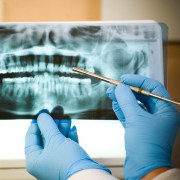 Photo: Getty Images
Photo: Getty Images
In my previous article I discussed mercury and vaccines as possible causes of autism. Now, I will look at elements that babies are exposed to in the womb that may predispose them to getting autism.
Mercury Amalgam Fillings
Mothers who have mercury fillings, which contain 50 percent mercury, when pregnant, or who have them before pregnancy, may have an increased risk of having a child with autism. Although mercury fillings have been used for more than 150 years, the safety of such a practice was not studied until recently.
A review published in 2009 found that:
"Mercury from maternal amalgam fillings leads to a significant increase of mercury concentration in the tissues and the hair of fetuses and newborn children. Furthermore, placental, fetal, and infant mercury body burden correlates with the numbers of amalgam fillings of the mothers. Finally, mercury levels in amniotic fluid and breast milk correlate significantly with the number of maternal dental amalgam fillings." (1)
So pregnant women who have mercury fillings could end up leaching mercury into their amniotic fluid and passing it through the placenta to give their babies' bodies burdensome amounts of mercury before they are even born.(6)
If the mother has the fillings removed during pregnancy, this can make the situation worse and cause more mercury to be released. When she begins to breast feed, her baby gets additional mercury from the milk. A study in sheep found that after ewes were given new amalgam fillings and they nursed foster lambs, the lambs received some of this mercury.
"Neonatal uptake of mercury (Hg) from milk was examined in a pregnant sheep model, where radioactive mercury (Hg203)/silver tooth fillings (amalgam) were newly placed. A crossover experimental design was used in which lactating ewes nursed foster lambs. Results from the animal studies showed that during pregnancy, a primary fetal site of amalgam Hg concentration is the liver and after delivery, the neonatal lamb kidney receives additional amalgam Hg from mother's milk. It was concluded that Hg originating from maternal amalgam tooth fillings transfers across the placenta to the fetus, across the mammary gland into milk ingested by the newborn, and ultimately into neonatal body tissues." (2)
Anti-D injections
Anti-D injections are given to rhesus (Rh) negative mothers during pregnancy to reduce the risk of fetal Rh (positive blood mixing with theirs and causing an immune system reaction). This is called rhesus disease or feto-maternal haemorrhage.
This can occur during childbirth but mainly occurs if the mother has had an invasive medical procedure such as amniocentesis or chorionic villus sampling. Feto-maternal haemorrhage can cause the baby to become anemic and need an in utero blood transfusion, which carries a 2 percent risk of fetal death. (3,4)
However, some brands of anti-D injection used to contain mercury and it has been implicated as a possible cause of autism. A 2008 study by the Institute of Chronic Illnesses found that Rh-negative mothers were much more likely to have children with neurological disorders, compared with Rh-positive mothers.
Thimerosal was removed from the U.S. anti-D injections in 2002 and researchers discovered that the children born in 2002 or later had the same risk of neurological disorder as those in the Rh-positive group, but those before 2002 had a higher risk, suggesting that the anti-D injection was the causative factor.
"There were significant and comparable increases in maternal Rh-negativity among children with NDs (Clinic: A=24.2 percent), autism spectrum disorders (Clinic: A=28.3 percent, B=25.3 percent), and attention-deficit-disorder/attention-deficit-hyperactivity-disorder (Clinic: A=26.3 percent) observed at both clinics in comparison to both control groups (Clinic: A=12.1%, B=13.9 Percent) employed. Children with NDs born after 2001 had a maternal Rh-negativity frequency (13.6 percent) similar to controls." (5)
Removing the mercury from anti-D injections seemed to be a positive step in reducing the number of children with autism and ASDs.
Sources:
1. A prospective study of prenatal mercury exposure from maternal dental amalgams and autism severity, Acta Neurobiologiae Experimentalis. Acta Neurobiol Exp 2009, 69: 1–9.
Abstract: http://www.iaomt.org/news/files/files302/Amalgam_Autism_Geier_2009.pdf
2. Vimy MJ et al., Mercury from maternal "silver" tooth fillings in sheep and human breast milk. Biol Trace Elem Res.1997 Feb;56(2):143-52. Abstract:
http://www.ncbi.nlm.nih.gov/pubmed/9164660
3. Birth Defects, Rh Disease, March of Dimes. Web. 9 September 2011. http://www.marchofdimes.com/birthdefects_rh.html
4. A156 Pregnancy (rhesus negative women) - routine anti-D (review): guidance, National Institute for Health and Clinical Excellence. Web. 9 September 2011.
http://guidance.nice.org.uk/TA156/Guidance/doc/English
5. Neurodevelopmental disorders, maternal Rh-negativity, and Rho(D) immune globulins: a multi-center assessment, Neuroendocrinology Letters. 2008 Apr;29(2):272-80. Abstract:
http://www.ncbi.nlm.nih.gov/pubmed/18404135
6. Lugliè PF et al. Mercury determination in human amniotic fluid. Minerva Stomatol. 2000 Apr;49(4):155-61.
Abstract:
http://www.ncbi.nlm.nih.gov/pubmed/11040541
Joanna is a freelance health writer for The Mother magazine and Suite 101 with a column on infertility, http://infertility.suite101.com/. She is author of the book Breast Milk: A Natural Immunization, and co-author of an educational resource on disabled parenting.
She is a mother of five who practised drug-free home birth, delayed cord clamping, full term breast feeding, co-sleeping, home schooling and flexi schooling and is an advocate of raising children on organic food.
Reviewed September 21, 2011
by Michele Blacksberg RN
Edited by Malu Banuelos






Add a Comment34 Comments
You cite Lugliè PF et al (2000) in support of your opinion that dental amalgam could pass from the mother into the amniotic fluid (AF) and hence into the fetus, causing neurological damage. Is there any reason to favour Lugliè PF et al (2000) over Lugliè PF et al (2005)? Is it because the more recent work does not support your opinion? According to the abstract http://www.ncbi.nlm.nih.gov/pubmed/14689312
"Number and surface areas of amalgam fillings influenced positively Hg concentration in AF but not at a significant level. Moreover Hg levels detected in AF were low and no adverse outcomes were observed through pregnancies and in the newborns."
September 25, 2011 - 3:58amThis Comment
In an earlier article in this series https://www.empowher.com/autism/content/autisms-theoretical-causes-genetics-and-metabolism-editorial?page=0,1 you wrote,
"So the neurologically normal babies who had been exposed to mercury in the womb via their mother’s fillings or anti-D injections, and after birth in the form of vaccines, had a higher level of mercury showing in their hair. Autistic babies exposed to the same things did not show this same level of mercury because they hadn’t excreted it from their bodies. (4)"
(4) Reduced levels of mercury in first baby haircuts of autistic children, International Journal of Toxicology. Web. 8 September 2011. http://www.ncbi.nlm.nih.gov/pubmed/12933322
Yet in the current article you argue that "Mercury from maternal amalgam fillings leads to a significant increase of mercury concentration in the tissues and the hair of fetuses and newborn children."
So which is it to be? Are mercury levels high in hair and tissues or are they high in tissues and low in hair in accord with the "poor excretor" theory you referenced in the earlier article. Both cannot be simultaneously true. Where you wrong then or now?
September 24, 2011 - 4:18pmThis Comment
According to those studies that I have read, that I quoted, mercury in the hair meant the child was excreting it from the body, so finding it in the tissues and hair is not surprising, it just means that the unborn child is excreting some of it which is obviously evidence of exposure from the mother.
And another thing, *I* personally am not arguing anything, I am a writer and I am reporting on possible causes of autism. I didn't conduct the research studies myself, I am reporting on what researchers have said on the matter. I personally believe that autism is caused by a variety of factors, mercury being one of them.
September 25, 2011 - 7:04amThis Comment
Mercury is not excreted from the body to the hair. Mercury in the hair is the same as the mercury in the blood at the time the hair was growing. When mercury is excreted in feces both blood and hair levels decline. This has been known for decades.
"Several studies suggest that infant animals may be more sensitive to toxic insult from methylmercury than adults. In our experiment, newly born infant monkeys were given equivalent daily doses of body weight orally in the form of methylmercury for more than 60 weeks. Data revealed that after weaning at 200 days, both blood and hair mercury showed a sudden drop which was accompanied by an increase in fecal mercury excretion." http://www.sciencedirect.com/science/article/pii/0378427483902084
Holmes et al (2003) claimed the opposite; that low levels of mercury in the hair was evidence of the body retaining mercury, the children were poor excretors and thus poisoned by low levels of mercury that were excreted by normal controls.
You cited Holmes et al (2003) approvingly in an earlier article when you argued that,
"the neurologically normal babies who had been exposed to mercury in the womb via their mother’s fillings or anti-D injections, and after birth in the form of vaccines, had a higher level of mercury showing in their hair. Autistic babies exposed to the same things did not show this same level of mercury because they hadn’t excreted it from their bodies." https://www.empowher.com/autism/content/autisms-theoretical-causes-genetics-and-metabolism-editorial?page=0,2
Now you are arguing that high levels of mercury in children's hair are also evidence of mercury poisoning. So which is it to be?
And if you are a writer reporting on possible causes of autism rather than an advocate for a particular cause of autism, shouldn't you be reporting on the science that contradicts the claims you are reporting on in your articles?
September 25, 2011 - 3:19pmThis Comment
I said it's evidence of mercury EXPOSURE from the mother. The study is exploring whether babies exposed to mercury in the womb then go on to have neurodevelopmental disorders. And if it's still in the tissues then it obviously hasn't been completely excreted.
The study did say that mercury in the hair meant the child was excreting it. If you want to say that isn't true, go and argue with the scientist who reached that conclusion.
The majority of science that contradicts the findings of the studies I mentioned is carried out by people who make vaccines, testify for the government against people injured by vaccines or who are involved with the drug companies in some way. The placebos are also not proper placebos. Placebos are meant to be harmless, like water, but they use things like aluminium or another vaccine - both of which can cause a variety of side-effects.
When they actually do a study that has a proper harmless placebo and isn't authored by someone in bed with pharmaceuticals, then I may well report. As it is, there is far more publicity given to the scientists that work for drug companies than for the scientists who have genuine concerns and just want to do their job and help patients.
There will always be reports contradicting when a concern comes out. Prior to the MMR publicity, there were only a handful of studies about it. Afterwards we have had study after study saying the concerning studies are false. It's a PR stunt, a damage control operation (if it wasn't, they would have had the same amount of studies before the publicity).
There were reports saying that smoking is safe. Shall I report on those??
September 26, 2011 - 2:09amThis Comment
There's more than one study cited and Mark is a doctor whether or not you agree with him. Yes she did vet my article. My personal observation is that anything involving mercury is immensely threatening to some, no matter the source. I think it's the fact that it may be iatrogenic that makes people defensive.
September 22, 2011 - 8:27amThis Comment
That fact that Mark Geier has an MD degree is irrelevant to the question of whether he is qualified to comment on vaccine safety. His expert opinion on vaccines and autism is routinely disallowed in court. His studies are regarded as worthless by bona fide researchers with the training and experience to be taken seriously. There's an excellent chance that by this time next year, Mark Geier won't be licensed to practice medicine in any state.
Do you have any credible evidence that the small amount of thimerosal once found in scheduled childhood vaccines was associated with autism? Can you explain why autism prevalence hasn't plummeted since thimerosal's removal from the pediatric schedule? I'm not interested in your "personal observation." You're a science writer for EmpowHer. Data please.
September 24, 2011 - 5:02pmThis Comment
As I already explained with links in the other thread, they removed it in some vaccines but added it in to other vaccines (for instance, they put in a DTaP vaccine with most thimerosal removed but at the same time added routine yearly flu vaccine for children, containing thimerosal).
http://www.cdc.gov/mmwr/preview/mmwrhtml/mm5001a3.htm (2001 schedule).
http://www.cdc.gov/mmwr/preview/mmwrhtml/mm5316-Immunizationa1.htm (2004 with flu vaccines added in).
And even the ones that say they are 'thimerosal free' aren't always. Some brands still use trace amounts of less than 3mcg per shot but are labelled as thimerosal free.
http://www.cdc.gov/vaccines/pubs/pinkbook/downloads/appendices/B/excipient-table-2.pdf
His expert opinion is dis-allowed because no one wants to hear opposing evidence.
September 25, 2011 - 6:56amThis Comment
Dr Geier's testimony was disallowed because the courts repeatedly found that he was not qualified to testify. the judges gave precise reasons why his testimony was inadmissible. Here are two examples.
“[T]he court has found, however,that Dr. Geier’s testimony must be excluded because he is not qualified as a pediatrician, neurologist, toxicologist, or epidemiologist, and because his opinion is not reliable… [T]here is no evidence that Dr. Geier has either the training or the background to diagnose autism or to treat autism in any child." http://www.neurodiversity.com/weblog/article/132
“[U]pon being subjected to extensive cross examination, much of Dr. Geier’s analysis, based upon his collective review of a motley assortment of diverse literature, proved, in the Court’s view, to be overstated… . For example, in examining Dr. Geier’s methodology, the Court notes that Dr. Geier could not point to a single study, including anything that he had published, that conclusively determined that the amount of thimerosal in RhoGAM when given not to the fetus but to the mother, as in this case, could cause autism… This Court must find more than the ‘hypothesis and speculation,’ engaged in by Dr. Geier in this instance, in order to allow Dr. Geier to rely upon the methodology he used in forming a conclusion based upon his review of the literature presented to the Court… [T]he Court finds that Dr. Geier’s literature review, in this instance, does not meet the Daubert standard of being both derived by the scientific method and relevant to the ‘task at hand.’”
September 25, 2011 - 2:36pm“…[T]he Court is particularly concerned as to a potential bias in Dr. Geier’s methodology and ultimate conclusion given the recency of Dr. Geier’s research into the cause of autism, which he admittedly began in only the last two and a half years, a time period that also represents the pendency of this lawsuit… [T]he Court finds that Dr. Geier (1) was not specifically qualified to perform a differential diagnosis of a pediatric neurological disorder, and, that (2) he did not properly perform the differential diagnosis given his failure to consider within his analysis the high probability that an unknown genetic cause cannot be ruled out as the specific cause of Minor Child Doe’s autism.” http://neurodiversity.com/weblog/article/102/
This Comment
Well, Geier has testified in 90 medical damage hearings and only been dis-allowed for 10, according to a Wikipedia smear article against him. He's been studying these issues since 1971 so I'm sure he's more qualified than even you to talk on this issue.
They are going to crack down on him because they do with any doctor who questions vaccines on any level. Practically every doctor that I have heard about who publically supports families of vaccine damaged children, has an investigation opened on them. They welcome people in to be vaccinated and say you are a good parent for doing it but when something goes wrong they slam the door in your face.
Today's 'science' is not really science because real science is re-evaluated constantly, ideas are openly discussed and debated, that is the nature of science. But with this particular issue there is no room for debate or discussion of any kind. Opposing evidence is ignored or explained away, those presenting with injuries are treated with contempt because their very presence challenges the status quo, doctors who dissent (and there are MANY) are struck off or they attempt to strike them off. The government took liability for MMR after the first brand caused outbreaks of meningitis in Canada. The drug manufacturer told them they wanted immunity if they wanted to market it in the UK. Is that really the actions of a community that wants to help children? So the pluserix MMR then caused meningitis in the UK and was withdrawn again. If anything is found wrong with vaccines, it's the government who is liable, not the vaccine companies and I think that's one of the reasons why scientific debate is no longer allowed. This is political.
As for 'neuro diversity', I don't believe in that theory (although I do intend to write an article on it even so). It runs contrary to the theory of evolution. Since humans first developed we have become progressively more advanced, we developed walking upright and speech and better cognitive function and have improved with each new species of human. Evolution goes forward. It says here:
'Charles Darwin simply brought something new to the old philosophy -- a plausible mechanism called "natural selection." Natural selection acts to preserve and accumulate minor advantageous genetic mutations. Suppose a member of a species developed a functional advantage (it grew wings and learned to fly). Its offspring would inherit that advantage and pass it on to their offspring. The inferior (disadvantaged) members of the same species would gradually die out, leaving only the superior (advantaged) members of the species.'
http://www.darwins-theory-of-evolution.com/
Having autism puts people at a disadvantage. I'm not talking about aspergers syndrome or high functioning autism, where the person can basically live a normal life (my own daughter was strangled on her cord in a hospital delivery, born blue, was different from birth and diagnosed with aspergers which I believe was caused by suffocation, yet she now lives a normal life). I'm talking about full blown autism where the child has no communication, has no bowel control, has seizures, developmental arrest, abdominal disease causing constant pain. A lot of these children are mentally disabled. None of these things are advantagious to the species. They can't grow up, lead independent lives, have jobs, get married etc and they require round the clock care. If they were in the wild like other animals are, they would be eaten.
I'm not being remotely discriminatory to disabled people, I am one (cerebral palsy and osteoarthritis and sensory processing faults), but the fact remains if I had to live in the wild I would not be able to hunt and I would probably be killed by other animals.
Genetic evolution would not go backwards and create lots of children who are unable to fend for themselves. Neuro diversity would go forward and instead create super smart humans.
September 26, 2011 - 1:38amThis Comment